Pansies: features, planting and care

Pansies, or viola, are flowers loved by gardeners who create a multi-colored and velvet carpet on the site. The characteristic shade range of this flower is yellow-violet. To date, breeders have bred about 200 varieties, each of which can become a real decoration of a flower bed.


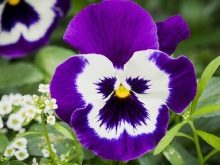
Description
Many growers are confused in the scientific and folk names of their favorite flowers. Some sources call the violet pansies, others say that the viola is just one of the varieties of the violet.
One way or another, pansies belong to the Violet family. This biennial plant is naturally distributed in the European part of Russia, as well as in certain regions of the Far East, Siberia and the Urals, it is found in Ukraine and Moldova, some varieties are even adapted to life in subarctic conditions. In nature, it grows like a weed, it is distinguished by its endurance and vitality - these properties made it possible to create strong hybrids adapted for breeding in a wide variety of climatic regions.
Subject to the rules of care for pansies, they can embellish garden plots even in regions with cold climates.



Their petals are very spectacular, the color range is so rich that even in photographs these flowers look very beautiful. The buds bloom in early spring, as soon as warm weather sets in, while some varieties bloom right up to the fall, endure the heat steadily, others bloom fully in Indian summer, as they are able to withstand light frosts.
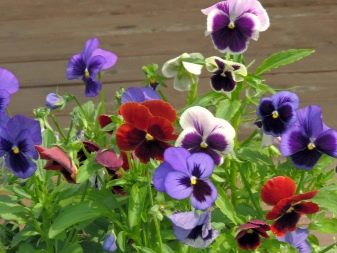

Depending on the variety, the stem grows from 10 to 35 cm, in some hybrid varieties it can reach 45 cm.As a rule, several curly or erect stems depart from the rhizome at once. They are slightly pubescent or naked, their shape is triangular, textured, ribbed. Numerous lateral roots of the fibrous type tightly enclose the main taproot.
The lower leaves are rather large, sitting on elongated petioles, the upper leaf plates are sessile, slightly oblong. Like the stems, the leaves are often covered with fine villi, depending on the variety and cultivar. Between the upper leaves and the stem are stipules - it is from them that flower stalks are thrown out in spring.


Flowers are solitary, varying from 6 to 10 cm in diameter, can emit a subtle pleasant smell. Each flower consists of clusters with 3-4 paired bracts. Corolla includes 5 petals, usually the lower one is unpaired, smaller than the other 4, and differs in color. In the center there are 5 stamens, each with anthers tightly pressed.
Pansies are well known for their unpretentiousness. They are perennials, but they are usually grown in accordance with the agrotechnics of a two-year crop.


The cultivated varieties really amaze with the variety of colors. In recent years, many species have been bred, the petals of which are painted in lilac, light blue, whitish and even reddish-brown shades. They usually have bright contrasting stripes, edging or eyes. The plant is not poisonous.
Many legends and legends are associated with pansies, this is not surprising, because a tricolor violet with its appearance evokes such an association, as if someone's gaze follows the road and warmly welcomes all visitors to the garden. Largely due to this, the tale of the young beauty Anyuta, waiting for her faithful lover, was born.



There are many signs associated with pansies. For example, for a long time in Russia it was believed that picking these flowers meant an imminent rain. Viola was depicted on the coat of arms of the city of Izhora near Karelia - this is an ancient city that existed in the 17th century. Pansies are also popularly called Ivan da Marya. This name is also associated with one of the romantic legends of love and fidelity. In some areas, the flower is called "moths" - and in fact, the flowers do resemble the fluttering of butterflies.
Popular rumor ascribes even magical properties to the tricolor violet - it is believed that with its help you can bewitch a loved one. But if this statement does not have any evidence under it, then the healing properties of the plant have long been recognized by official medicine. Viola grass and flowers are used to create preparations of insulin and other glycosides that regulate the work of the endocrine glands. The violet tricolor has also been used in alternative medicine - here it is widely in demand for the preparation of a cough medicine, as well as diuretic decoctions.


Views
All series of pansies are conventionally divided into 2 groups:
- with large flowers - their diameter is 10 cm;
- with small flowers - diameter is about 6 cm.
The size of the flowers of all other species is approximately in between.


Many growers believe that the more flowers, the better and more beautiful the flower bed will be. However, as practice shows, it is the small-flowered crops that are the most hardy and strong, they are adapted for growing in the most unpleasant weather conditions, they easily tolerate temperature extremes, heavy rains and mild drought. Moreover, despite the fact that the flowers are small, there are a lot of them, so the carpet turns out to be even brighter and more colorful than when planting bushes with large flowers.
In cold regions, small-shrub varieties always win, but in the south they have also become popular, however, it should be noted that in hot climatic conditions the flowers gradually decrease in size, so by planting a small-flowered viola variety in April, you will get a very tiny flower by the end of the season. For this reason, mainly large-flowered varieties are grown in flower beds there, and small-flowered varieties are left for growing at home on balconies and loggias.




By the size of the bush, the tricolor violet is divided into low, medium and tall varieties.
Depending on the edge of the pansy petals, the pansy can be:
- with even petals;
- with a wavy edge.
The color palette distinguishes:
- varieties with monochrome colors;
- two-color;
- with contour blots and stripes.
Pansies are represented by more than 15 categories of flowering horticultural crops, which vary significantly in color, size, shape, frost resistance and flowering time.

The most popular varieties include several.
"Freedom" - pansies with flowers about 5 cm in diameter. They are quite close to each other and grow well. The plant is distinguished by its unpretentiousness, frost resistance and endurance under the influence of unfavorable weather factors, it tolerates heat and prolonged rains better than all other representatives of its group. Usually grown in combination with other spring flowers.
Seedlings are harvested from January to February, which are transferred to open ground until mid-summer. In this case, flowering, as a rule, occurs as early as the next year.
The plant prefers well-lit areas, regular watering. For a more lush flowering, dried flowers are removed.

"Blueberries with cream" - a low-growing violet no more than 15 cm high. The color of the petals is dark purple with a white edging. Thanks to such an unusual color palette of pansies, this variety looks extremely impressive, so they are often used to decorate flower beds and borders, as well as in flower beds. The variety is characterized by resistance to low temperatures, unpretentious care. Prefers fertile loose soils and well-lit areas, but can grow in the shade.

"Viola Aurora" - this variety is a fairly compact bushes that are highly branched, up to 20-25 cm high. The bloom is abundant, the average flower size is 5-7 cm, the color can change its saturation depending on the temperature and the level of illumination, which creates an unusual play of color on the buds. The petals are corrugated, with edging at the edges. It is used for growing in open areas as a curb horticultural crop, as well as for decorating balconies and window containers.
Seedlings are sown in March. Flowering occurs in the same year. The seedlings are moved to the ground until frost.
To achieve flowering for the next season, they should be transplanted to a permanent site in June-July. The culture prefers fertile, drained soil, grows well in the sun and in partial shade.

"Waterfall" is an ampelous viola, which is popular in vertical gardening. It is grown in hanging pots and containers. The flowers are golden in color, their size is about 5 cm. The cascading shoots grow up to 25-35 cm. The very first flowering occurs in May, and it ends in early autumn. When planted on seedlings in February, it blooms in the first year. The culture is resistant to frost, loves well-moistened soil and sunlight.
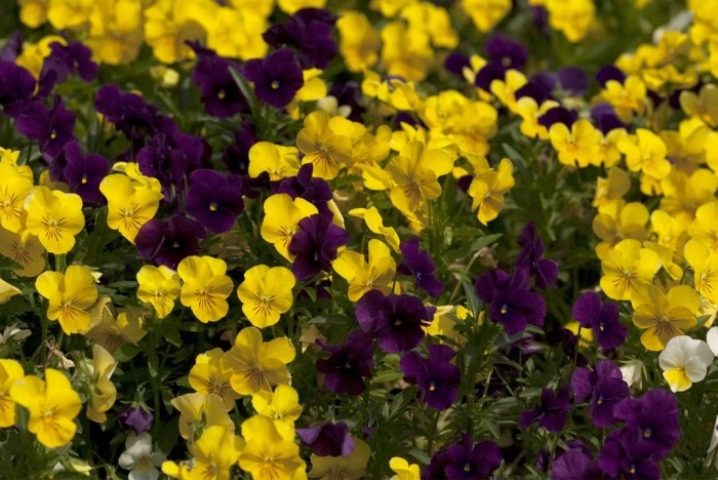
"Velor" - compact bushes about 20 cm high and about 30 in diameter. The flowers are small - 3-4 cm, located tightly to each other, forming a large and lush ball, their colors are bright, saturated.
Viola "Velor" requires drained soils with high air permeability, can grow both in the sun and in light shade. Growing for seedlings is carried out in February, and at the end of May they are moved into open ground to a permanent place, then flowering begins the next year. The plant is unpretentious, easily tolerates adverse weather conditions. It is used to decorate alpine slides and borders.

Viola "Wittroca Alpensee" - short bushes only 15 cm long. The plant is extremely unpretentious, prefers sunny areas and good watering. It tolerates a slight drop in temperatures with ease. When planted on seedlings, it can bloom in the same season, when planting in open ground - only the next. Flowering lasts from May to October. The culture is most often used for growing in balcony containers and garden vases, as well as as part of a bed.

"Empire" has rather large flowers with a diameter of about 10 cm. The plant is distinguished by exceptional decorativeness due to its bright and eye-catching colors. We need regular, moderate watering.
When the temperature is kept at 16 degrees, it produces the largest flowers.

"Russian beauty". Pansies of this series give rather large flowers 7-9 cm in size, the bushes are low - about 15 cm. They belong to the early flowering varieties, grown in the shade or in the sun, and are easy to care for. It is characterized by increased cold resistance and can grow in conditions of a lack of land volume.

"Evening heat" is a flowering plant. The diameter of the flowers is 5-6 cm, each is located on a long peduncle, reaching 10 cm. The flowers are dull, with wavy edges. The height of the bush is 10-15 cm.

Ice King - this viola grows up to 20 cm, the flowers are white with a slight green tint, the lower petals are decorated with purple spots.

"Weiss" - in comparison with all other varieties has a truly gigantic size - grows up to 25 cm. The flowers are about 7 cm in diameter, their color is snow-white, the middle is yellow, the edging is wavy.

"Tiger's eye" has an unusual color, visually reminiscent of a tiger's eye. The bush is small ,. grows only up to 20 cm, but usually grows into a lush carpet. The flowers are yellow with textural black stripes, the diameter of each does not exceed 3-4 cm. The variety feels great in any type of soil, subject to good water permeability and effective drainage.

"Adonis" is the fastest and longest flowering variety. Sufficiently compact bushes, no more than 15 cm in length, large flowers. A pair of their upper petals are blue, the lower ones - with white-purple spots. It is planted in groups.


How to plant?
Before planting pansies, first of all, you should decide on the variety and choose the optimal place for them. Most gardeners prefer different-sized varieties - small-flowered ones are more hardy, and large-flowered ones look great in a flower bed in combination with other plants.
It is best to select open areas under the viola, so that access to them by the sun's rays is at least 6-7 hours a day. Viola-friendly landing parameters.
- Soil type - for a tricolor violet, a fertile, drained soil is needed, necessarily fertilized in order to saturate the flower roots with all the necessary nutrients. Dry soils and soil with stones are not suitable for this plant.
- Shading - here it is desirable to find the "golden mean". So, when a flower is in a constant thick shade, its degeneration begins, but the scorching sun is able to destroy this flower.


There are several ways to plant pansies.
The first is growing viola from seeds. Planting time depends only on when exactly you want to get a lush blooming crop. The most common mistake is growing seedlings too late. Keep in mind that pansies prefer coolness, as they have never been a tropical dweller.
The optimum temperature for the comfortable development of a flower is considered to be a level of 18-20 degrees. Do not sprout them in containers where you previously kept the bulbs of other garden plants - they are quite often infected with thrips, which, as you know, are very fond of feasting on young sprouts of violets.
Perennials are planted directly in the open ground or also by the seedling method. In this case, the sequence of actions will be slightly different.


The planting technology is simple - the seeds are spread over the prepared soil, and then sprinkled with sand or vermiculite. They do not germinate in the light, so it is covered with film or glass to create the effect of a greenhouse. Watering should be drip or through a pan. Do not forget to air your greenhouse every day, otherwise cold-loving plants will simply be baked under such a shelter.
The first shoots appear in about 10-14 days. After that, the container should be moved to a bright and cool place - a cold greenhouse or unheated room is best for this.
If you additionally highlight the seedlings with phytolamps, then you need to place it at a distance of 5-8 cm from the seedling container.

A month later, you can pick the seedlings and transplant them into pots. When the outside air temperature reaches 5 degrees, young plants can be taken out into the fresh air so that they become hardened - this will help them to adapt more quickly to growing in open areas in the future.
When the plants are 10-11 weeks old, you can move them to a protected bed. Young shoots are planted in the ground and covered with a large layer of straw or a special covering material so as not to obstruct air access and at the same time not create a greenhouse effect.The planted flowers are watered once every 7 days, fertilizing is applied every 10 days, alternating mineral and organic fertilizers. At the end of summer, the viols will get stronger and adapt to the surrounding factors sufficiently, so they are transplanted to a permanent place.
Keep in mind that it is imperative to avoid flowering during this time, as this will severely drain the plant before hibernation.


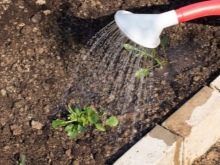
If all the requirements of agricultural technology have been met, then next spring you will be able to enjoy the unusual appearance and enchanting aroma of these flowers.

Despite the fact that viola is a fairly unpretentious crop, its planting has a number of nuances, on the observance of which the splendor and juiciness of further flowering depends. During landing, you must follow a number of rules:
- before planting, the soil should be loosened and slightly moistened;
- seedlings must be mixed with sand before planting, otherwise the seeding density will be too intense and uneven;
- the seeds do not need to be buried too deep, the layer of sand should be minimal, superficial;
- watering is best done by drip or through a strainer, otherwise the seeds can simply be washed off with water;
- during the first week, the container with the seed is stored in a dark place, and then transferred to slightly brighter rooms.


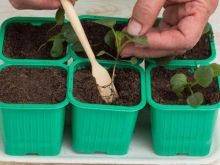
How to take care of it properly?
Growing pansies is not difficult. All they need is fertile soil with good drainage and a place open to sunlight. Regardless of the characteristics of the climate, the land should have high indicators of water resistance, since in conditions of waterlogging of the soil, the plant gets sick with root rot. If you are in doubt about the quality of the soil, plant your tricolor violets in a high bed.
For top dressing, it is best to use compost, as well as mineral compositions with a high content of potassium and phosphorus and a small amount of nitrogen.

If you want your tricolor violets to bloom for as long as possible, you need to remove all wilted flowers in a timely manner, and with the arrival of cold weather, mulch the beds - the roots of violets are shallow, therefore artificial warming of the earth will help prolong the period of budding and flowering. It will not be superfluous to cut off all the seed boxes in August - then the plant will delight you with its exuberant color until the onset of severe cold weather.
If you planted viols in September-October, then they need to be preserved in the winter. To do this, create a high bed near a wall or other vertical structure. It is very important during this period to exclude the harmful effects of wind and high humidity - they can destroy the wintering flower. Planting should be carried out a month before the onset of frost, otherwise the roots simply will not be able to adapt.


The snow cover is a very good shelter for pansies, but if the winter has little snow and cold, then you need to cover the beds with coniferous branches or spruce branches.
Fallen leaves are not recommended to be used as mulch - they will absorb too much water and can cause rotting of immature plants.


Growing at home
Viola is often used in home gardening. It blooms best on open balconies located on the south, east or west side. On dull glazed loggias, development is much slower - the plants begin to stretch out, and their flowering is rather scarce. Some even grow a crop on ordinary window sills, but this is possible only if the window is constantly open - the basis for a full-fledged cultivation of a garden crop at home is a sufficient amount of fresh air and bright light.
In houses and apartments, viola is planted in long balcony boxes and flower pots, ampelous varieties are grown in hanging pots and containers on a leg.Any pot must have large drainage holes. The fact is that the roots of pansies have a predisposition to rotting, therefore at the bottom there must certainly be an impressive layer of large pebbles, shards of brick, expanded clay or foam, at least 2-3 cm thick.
The soil mixture, which is poured from above, should be distinguished by high water and air permeability.



When planting in balcony flowerpots between each bush, you should keep distance 15-20 cm. The height of the pot should be selected so that there is 1-2 liters of soil mixture per plant.
When growing tricolor violets in the house, it is extremely important to monitor the frequency of watering - in summer, when the indoor air is very dry, it must be done twice a day (in the mornings and evenings).

Two weeks after planting the viola in open ground, you can carry out the first top dressing. Further, the fertilization of viols grown in apartments is carried out weekly. It is advisable to use ready-made mineral preparations for decorative flowering crops.
During hot weather, pansies can lose their decorative effect. Usually, their stems begin to turn yellow and fall off, flowering becomes rare, and the flowers themselves are significantly reduced in size. In such a situation, the tricolor violets should be cut off by a third of the stem length. If the bush has completely lost its beauty, then pruning is carried out at a height of 5-6 cm from the root collar (while leaves should remain). After a couple of weeks, the viol bush will form new shoots and begin to bloom.

Reproduction
We have already discussed the features of viola seed reproduction above and will not repeat ourselves, we will only clarify that when planting in the ground, you must definitely observe zoning rules for flowers of different varieties. Otherwise, cross-pollination occurs, and the next year the plants will look a little different - sometimes not at all the way their owners want.
Few people know that annual and perennial pansies can also be grown by cuttings. Usually, in the second season, the flowers become smaller and require renewal. To do this, the bed is thinned out, leaving on each bush only stems with unblown ovaries, and bushes cut off at the end of May with a couple of internodes are transplanted into a universal soil. During this period, the plant requires abundant watering, preferably with the use of biostimulants - this way the development of the root system will go faster. If the summer is dry, then cuttings are carried out under the film, since at this stage it is important to maintain constant moisture in the upper layer of the earth.
Usually, the branches very quickly grow full-fledged roots and in the fall the pansies will be able to please with their lush flowering. By the way, this method is often used to rejuvenate flower culture.

Diseases and pests
Despite the persistence and vitality of pansies, they often fall prey to infections and garden pests. Viols have a lot of diseases.
- Powdery mildew - it affects the whole plant, the diseased areas die off rather quickly, and new buds are not formed at the same time. In this case, you need to remove all damaged parts of the flower and treat it with an aqueous solution of laundry soap.
- Gray rot often infects violets, causing blackening of all stems, leaves and roots of the plant. To save pansies, it is necessary to process the flower with copper oxychloride 4 times with an interval of 7 days.
- Spotting leads to premature death of leaves and a slowdown in flowering. In this case, use the same methods as for gray rot.
- Blackleg assumes decay of the root collar, occurs with excessive watering and waterlogging of the grant. It is impossible to save the culture, therefore from the very beginning it is important to observe the irrigation regime and select well-drained soils for planting.




The main pests of pansies are spider mites and aphids. Diseased plants begin to wither, stop producing buds and stop blooming. Do not mind eating the green parts of the viola slugs and nematodes. The worst thing is that they not only damage the flower, but also become carriers of infection, therefore, in the fight against such pests, you must immediately use a set of preparations of both fungicidal and insecticidal action.
When caring for pansies, it is important to learn one rule - in most diseases, the flower growers themselves are to blame, since any deviations from agricultural technology and crop cultivation inevitably lead to a weakening of the plant's immunity. As a result, the flowers become defenseless under the attack of bacteria, viruses and parasites.


Use in landscape design
Pansies look spectacular in combination with other flowers such as aster, daisy, forget-me-nots and iberis. Lobelia will also be a good neighbor for violets.
When planting some pansies, it looks like a blooming carpet. In this case, select a multi-colored mixture or varieties of the same shade.
Viols look great on emerald green lawns, they are planted with garden paths, grown in hanging pots, decorate loggias and balconies.
Planting a plant is not difficult, but it looks invariably impressive, delighting the owners of the house and its guests with its bright radiance.


For information on how to care for pansies, see the next video.





































































































The comment was sent successfully.